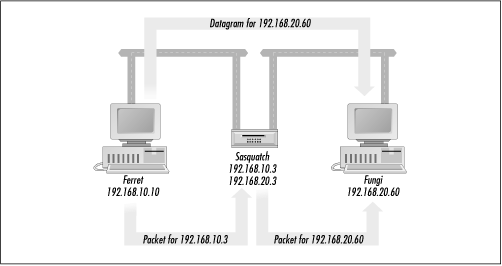IP Datagrams Versus IP Packets
Hosts on an IP network exchange information using IP datagrams, which include both the units of data that contain whatever information is being exchanged and the header fields that describe that information (as well as describing the datagram itself). Whenever a device needs to send data to another system over an IP network, it will do so by creating an IP datagram, although the datagram is not what gets sent by IP, at least not in the literal sense.
Instead, IP datagrams get sent as IP packets, which are used to relay the IP datagrams to the destination system, one hop at a time. Although in many cases an IP datagram and an IP packet will be exactly the same, they are conceptually different entities, which is an important concept for understanding how IP actually works.
This concept is illustrated in Figure 2.1. In that example, Ferret needs to send an IP datagram to Fungi. However, since Fungi is on a remote network, Ferret has to send the packet containing the datagram to Sasquatch, who will then send another packet to Fungi.

IP datagrams contain whatever data is being sent (and the associated IP headers), while IP packets are used to get the datagram to the destination system (as specified in the IP headers). These IP packets are sent using the framing mechanisms defined for the specific network medium ...
Get Internet Core Protocols: The Definitive Guide now with the O’Reilly learning platform.
O’Reilly members experience books, live events, courses curated by job role, and more from O’Reilly and nearly 200 top publishers.

